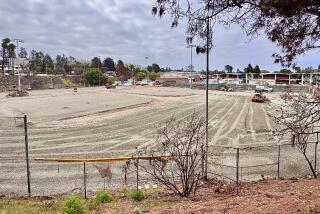Hard-Hat High : Classes Begin at Unfinished School in Rancho Bernardo
- Share via
The first sign you see when driving into Rancho Bernardo High School doesn’t exactly inspire academic revelation; it proclaims the school to be a “Hard Hat Area.”
Despite the dirt roads, lack of landscaping, ongoing construction and the fact that the cafeteria and special education, art, photography and journalism classrooms won’t be open until February, the school welcomed its first 1,400 students on Monday.
Lunch was served out of carts reminiscent of corner hot dog stands sans the umbrellas, and, since the gymnasium won’t be completed until May, students, dressed in shorts and T-shirts, were seen running around the parking lot and down the bleachers of the yet-to-be-finished football field as part of their physical education class.
These makeshift situations notwithstanding, Principal Sandra Johnson said things are going “remarkably smoothly,” and she has nothing but praise for her $37-million new school.
But most noticeable at the new school, located on Paseo Lucido in Rancho Bernardo, are the white, pyramid-shaped roofs on the buildings that feature skylights.
The skylight roofs reduce electricity costs for lighting, said architect Steve Gustafson.
“They are designed so that you can hold a class without turning on the lights,” said Gustafson, who estimated the unusual design will chop 30% off electricity bills.
“On most days, you will not have to turn on the lights.”
Gustafson said the classrooms also are equipped with photocells that prevent a person from turning on more lights if there is already sufficient light in the room.
When artificial lights are used, the power will come from a central energy plant that can store energy at night, when rates are lower, for use in the daytime.
“Being in a class, it’s so different because, it’s not closed in on you,” said Meagan Foley, a sophomore, of the roofs.
“When you’re in a flat-roofed class, it’s like you’re closed in.”
The field of pyramids, while energy-efficient, was also designed with aesthetics in mind, Gustafson said.
“We wanted to somehow mirror the mountains, to have some kind of a visual relationship between the roof images on the school and the peaks of the mountains,” Gustafson said.
“The focus of this project is on the hills because we felt that it was the most pleasant image here,” he said with his back to Twin Peaks.
The school is the third comprehensive high school in the district, and the first new one since Mt. Carmel in 1976.
It is designed to eventually hold 3,000 students, a figure school administrators say will be reached in the next few years.
More to Read
Sign up for Essential California
The most important California stories and recommendations in your inbox every morning.
You may occasionally receive promotional content from the Los Angeles Times.













